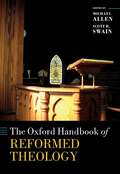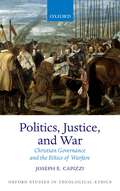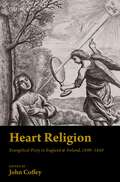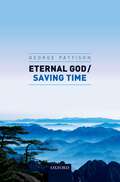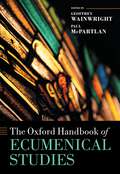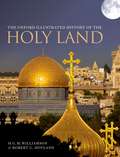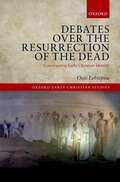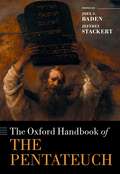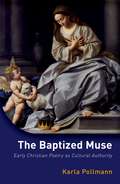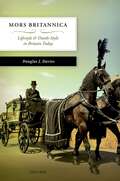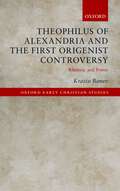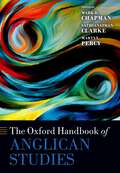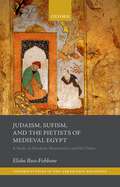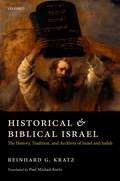- Table View
- List View
The Oxford Handbook of Reformed Theology (Oxford Handbooks)
by Michael Allen Scott R. SwainThe Oxford Handbook of Reformed Theology looks back to past resources that have informed Reformed theology and surveys present conversations among those engaged in Reformed theology today. First, the volume offers accounts of the major historical contexts of reformed theology, the various relationships (ancient and modern) which it maintains and from which it derives. Recent research has shown the intricate ties between the patristic and medieval heritage of the church and the work of the reformed movement in the sixteenth century. The past century has also witnessed an explosion of reformed theology outside the Western world, prompting a need for attention not only to these global voices but also to the unique (and contingent) history of reformed theology in the West (hence reflecting on its relationship to intellectual developments like scholastic method or the critical approaches of modern biblical studies). Second, the volume assesses some of the classic, representative texts of the reformed tradition, observing also their reception history. The reformed movement is not dominated by a single figure, but it does contain a host of paradigmatic texts that demonstrate the range and vitality of reformed thought on politics, piety, biblical commentary, dogmatic reflection, and social engagement. Third, the volume turns to key doctrines and topics that continue to receive attention by reformed theologians today. Contributors who are themselves making cutting edge contributions to constructive theology today reflect on the state of the question and offer their own proposals regarding a host of doctrinal topics and themes.
Politics, Justice, and War: Christian Governance and the Ethics of Warfare (Oxford Studies in Theological Ethics)
by Joseph E. CapizziThe just war ethic emerges from an affirmative response to the basic question of whether people may sometimes permissibly intend to kill other people. In Politics, Justice, and War, Joseph E. Capizzi clarifies the meaning and coherence of the 'just war' approach, to the use of force in the context of Christian ethics. By reconnecting the just war ethic to an Augustinian political approach, Capizzi illustrates that the just war ethic requires emphasis on the 'right intention', or goal, of peace as ordered justice. With peace set as the goal of war, the various criteria of the just war ethic gain their intelligibility and help provide practical guidance to all levels of society regarding when to go to war and how to strive to contain it. So conceived, the ethic places stringent limits on noncombatant or 'innocent' killing in war, helps make sense of contemporary technological and strategic challenges, and opens up space for a critical and constructive dialogue with international law.
Roman Faith and Christian Faith: Pistis and Fides in the Early Roman Empire and Early Churches
by Teresa MorganThis study investigates why 'faith' (pistis/fides) was so important to early Christians that the concept and praxis dominated the writings of the New Testament. It argues that such a study must be interdisciplinary, locating emerging Christianities in the social practices and mentalités of contemporary Judaism and the early Roman empire. This can, therefore, equally be read as a study of the operation of pistis/fides in the world of the early Roman principate, taking one but relatively well-attested cult as a case study in how micro-societies within that world could treat it distinctively. Drawing on recent work in sociology and economics, the book traces the varying shapes taken by pistis/fides in Greek and Roman human and divine-human relationships: whom or what is represented as easy or difficult to trust or believe in; where pistis/fides is 'deferred' and 'reified' in practices such as oaths and proofs; how pistis/fides is related to fear, doubt and scepticism; and which foundations of pistis/fides are treated as more or less secure. The book then traces the evolution of representations of human and divine-human pistis in the Septuagint, before turning to pistis/pisteuein in New Testament writings and their role in the development of early Christologies (incorporating a new interpretation of pistis Christou) and ecclesiologies. It argues for the integration of the study of pistis/pisteuein with that of New Testament ethics. It explores the interiority of Graeco-Roman and early Christian pistis/fides. Finally, it discusses eschatological pistis and the shape of the divine-human community in the eschatological kingdom.
Heart Religion: Evangelical Piety in England & Ireland, 1690-1850
The Evangelical Revival of the mid-eighteenth century was a major turning point in Protestant history. In England, Wesleyan Methodists became a separate denomination around 1795, and Welsh Calvinistic Methodists became independent of the Church of England in 1811. By this point, evangelicalism had emerged as a major religious force across the British Isles, making inroads among Anglicans as well as Irish and Scottish Presbyterians. Evangelical Dissent proliferated through thousands of Methodist, Baptist, and Congregational churches; even Quakers were strongly influenced by evangelical religion. The evangelicals were often at odds with each other over matters of doctrine (like the 'five points' of Calvinism); ecclesiology (including the status of the established church); politics (as they reacted in various ways to the American and French Revolutions); and worship (with the boisterous, extemporary style of Primitive Methodists contrasting sharply with the sober piety of many Anglican advocates of 'vital religion'). What they shared was a cross-centred, Bible-based piety that stressed conversion and stimulated evangelism. But how was this generic evangelical ethos adopted and reconfigured by different denominations and in very different social contexts? Can we categorise different styles of 'heart religion'? To what extent was evangelical piety dependent on the phenomenon of 'revival'? And what practical difference did it make to the experience of dying, to the parish community, or to denominational politics? This collection addresses these questions in innovative ways. It examines neglected manuscript and print sources, including handbooks of piety, translations and abridgements, conversion narratives, journals, letters, hymns, sermons, and obituaries. It offers a variety of approaches, reflecting a range of disciplinary expertise—historical, literary, and theological. Together, the contributions point towards a new account of the roots and branches of evangelical piety, and offer fresh ways of analysing the history of Protestant spirituality.
Eternal God / Saving Time
by George PattisonStarting from the assumption that 'time is the horizon of the meaning of Being' (Heidegger), Eternal God/ Saving Time attempts to discover what the central religious idea of eternity or of God as 'the Eternal' might mean today. Negotiating ideas of divine timelessness and sempiternity (everlastingness) as well as the attempts of some philosophers to develop the idea of a temporal God, Professor George Pattison surveys a range of positions from analytic philosophy and from the continental tradition from Spinoza through Hegel to the present. Intellectual and cultural forces have tended to separate time and eternity, and both philosophical and theological examples of this tendency are examined. Nevertheless, starting from the experience of life in time, some modern thinkers have developed a new approach to the Eternal as what grounds or gives time. This leads through ideas of novelty, utopia, hope, promise, and call to the projection of a creative and transformative memory-remembering the future-that affirms human solidarity and mutual responsibility. Even if this cannot be made good in terms of knowledge, it offers a basis for hope, prayer, and commitment and these options are explored through a range of Christian, Jewish, Greek, and secular thinkers. This development re-envisages the idea of redemption, away from the Augustinian view that time is what we need to be rescued from and towards the idea that time itself might save us from all that is destructive and tyrannical in time's rule over human life.
Victorian Christianity and Emigrant Voyages to British Colonies c.1840 - c.1914
by Rowan StrongVictorian Christianity and Emigrant Voyages to British Colonies c.1840 - c.1914 considers the religious component of the nineteenth-century British and Irish emigration experience. It examines the varieties of Christianity adhered to by most British and Irish emigrants in the nineteenth century, and consequently taken to their new homes in British settler colonies. Rowan Strong explores a dimension of this emigration history that has been overlooked by scholars—the development of an international emigrants' chaplaincy by the Church of England that ministered to Anglicans, Nonconformists, as well as others, including Scandinavians, Germans, Jews, and freethinkers. Using the sources of this emigrants' chaplaincy, Strong also makes extensive use of the shipboard diaries kept by emigrants themselves to give them a voice in this history. Using these sources to look at the British and Irish emigrant voyages to new homes, this study provides an analysis of the Christianity of these emigrants as they travelled by ship to British colonies. Their ships were floating villages that necessitated and facilitated religious encounters across denominational and even religious boundaries. It argues that the Church of England provided an emigrants' ministry that had the greatest longevity, breadth, and international structure of any Church in the nineteenth century. The book also examines the principal varieties of Christianity espoused by most British emigrants, and argues this religion was more central to their identity and, consequently, more significant in settler colonies than many historians have often hitherto accepted. In this way, the Church of England's emigrant chaplaincy made a major contribution to the development of a British world in settler colonies of the empire.
How the Light Gets In: Ethical Life I
by Graham WardHow the Light Gets In: Ethical Life I presents a systematic account of the teachings of the Christian faith to offer a vision, from a human, created, and limited perspective, of the ways all things might be understood from the divine perspective. It explores how Christian doctrine is lived, and the way in which beliefs are not simply cognitive sets of ideas but embodied cultural practices. Christians learn how to understand the contents of their faith, learn the language of the faith, through engagements that are simultaneously somatic, affective, imaginative, and intellectual. In the first of four volumes, Graham Ward examines the complex levels of these engagements through three historical developments in the systematic organization of doctrine: the Creeds, the Summa, and Protestant dogmatics. He outlines a methodology for exploring and practicing systematic theology that captures how the faith is lived in cultural, social, and embodied engagements. Ward then unpicks several fundamental theological concepts and how they are to be understood from the point of view of an engaged systematics: truth, revelation, judgement, discernment, proclamation, faith seeking understanding, and believing as it relates to and grounds the possibilities for faith. This groundbreaking work offers an interdisciplinary investigation through poetry, art, film, the Bible and theological discourse, analysing the human condition and theology as the deep dream for salvation. The final part relates theology as a lived and ongoing pedagogy concerned with individual and corporate formation to biological life, social life, and life in Christ. Here an approach to living theologically is sketched that is the primary focus for all four volumes: ethical life.
The Oxford Handbook of Ecumenical Studies (Oxford Handbooks)
The Oxford Handbook of Ecumenical Studies is an unparalleled compendium of ecumenical history, information and reflection. With essay contributions by nearly fifty experts in their various fields, and edited by two leading international scholars, the Handbook is a major resource for all who are involved or interested in ecumenical work for reconciliation between Christians and for the unity of the Church. Its six main sections consider, respectively, the different phases of the history of the ecumenical movement from the mid-nineteenth century to the present; the ways in which leading Christian churches and traditions, Orthodox, Anglican, Methodist, Catholic, Lutheran, Reformed, Baptist, and Pentecostal, have engaged with and contributed to the movement; the achievements of ecumenical dialogue in key areas of Christian doctrine, such as Christology and ecclesiology, baptism, Eucharist and ministry, morals and mission, and the issues that remain outstanding; various ecumenical agencies and instruments, such as covenants and dialogues, the World Council of Churches, the Pontifical Council for Promoting Christian Unity and the Global Christian Forum; the progress and difficulties of ecumenism in different countries, areas and continents of the world, the UK and the USA, Africa, Asia, South America, Europe, and the Middle East, ; and finally two all-important questions are considered by scholars from various traditions: what would Christian unity look like and what is the best method for seeking it? This is a remarkably comprehensive account and assessment of one of the most outstanding features of Christian history, namely the modern ecumenical movement.
The Oxford Handbook of Ecumenical Studies (Oxford Handbooks)
by Paul McPartlan † Geoffrey WainwrightThe Oxford Handbook of Ecumenical Studies is an unparalleled compendium of ecumenical history, information and reflection. With essay contributions by nearly fifty experts in their various fields, and edited by two leading international scholars, the Handbook is a major resource for all who are involved or interested in ecumenical work for reconciliation between Christians and for the unity of the Church. Its six main sections consider, respectively, the different phases of the history of the ecumenical movement from the mid-nineteenth century to the present; the ways in which leading Christian churches and traditions, Orthodox, Anglican, Methodist, Catholic, Lutheran, Reformed, Baptist, and Pentecostal, have engaged with and contributed to the movement; the achievements of ecumenical dialogue in key areas of Christian doctrine, such as Christology and ecclesiology, baptism, Eucharist and ministry, morals and mission, and the issues that remain outstanding; various ecumenical agencies and instruments, such as covenants and dialogues, the World Council of Churches, the Pontifical Council for Promoting Christian Unity and the Global Christian Forum; the progress and difficulties of ecumenism in different countries, areas and continents of the world, the UK and the USA, Africa, Asia, South America, Europe, and the Middle East, ; and finally two all-important questions are considered by scholars from various traditions: what would Christian unity look like and what is the best method for seeking it? This is a remarkably comprehensive account and assessment of one of the most outstanding features of Christian history, namely the modern ecumenical movement.
The Oxford Illustrated History of the Holy Land (Oxford Illustrated History)
The Oxford Illustrated History of the Holy Land covers the 3,000 years which saw the rise of Judaism, Christianity, and Islam - and relates the familiar stories of the sacred texts with the fruits of modern scholarship. Beginning with the origins of the people who became the Israel of the Bible, it follows the course of the ensuing millennia down to the time when the Ottoman Empire succumbed to British and French rule at the end of the First World War. Parts of the story, especially as known from the Bible, will be widely familiar. Less familiar are the ways in which modern research, both from archaeology and from other ancient sources, sometimes modify this story historically. Better understanding, however, enables us to appreciate crucial chapters in the story of the Holy Land, such as how and why Judaism developed in the way that it did from the earlier sovereign states of Israel and Judah and the historical circumstances in which Christianity emerged from its Jewish cradle. Later parts of the story are vital not only for the history of Islam and its relationships with the two older religions, but also for the development of pilgrimage and religious tourism, as well as the notions of sacred space and of holy books with which we are still familiar today. From the time of Napoleon on, European powers came increasingly to develop both cultural and political interest in the region, culminating in the British and French conquests which carved out the modern states of the Middle East. Sensitive to the concerns of those for whom the sacred books of Judaism, Christianity, and Islam are of paramount religious authority, the authors all try sympathetically to show how historical information from other sources, as well as scholarly study of the texts themselves, enriches our understanding of the history of the region and its prominent position in the world's cultural and intellectual history.
The Oxford Illustrated History of the Holy Land (Oxford Illustrated History)
by Robert G. Hoyland H. G. M. WilliamsonThe Oxford Illustrated History of the Holy Land covers the 3,000 years which saw the rise of Judaism, Christianity, and Islam - and relates the familiar stories of the sacred texts with the fruits of modern scholarship. Beginning with the origins of the people who became the Israel of the Bible, it follows the course of the ensuing millennia down to the time when the Ottoman Empire succumbed to British and French rule at the end of the First World War. Parts of the story, especially as known from the Bible, will be widely familiar. Less familiar are the ways in which modern research, both from archaeology and from other ancient sources, sometimes modify this story historically. Better understanding, however, enables us to appreciate crucial chapters in the story of the Holy Land, such as how and why Judaism developed in the way that it did from the earlier sovereign states of Israel and Judah and the historical circumstances in which Christianity emerged from its Jewish cradle. Later parts of the story are vital not only for the history of Islam and its relationships with the two older religions, but also for the development of pilgrimage and religious tourism, as well as the notions of sacred space and of holy books with which we are still familiar today. From the time of Napoleon on, European powers came increasingly to develop both cultural and political interest in the region, culminating in the British and French conquests which carved out the modern states of the Middle East. Sensitive to the concerns of those for whom the sacred books of Judaism, Christianity, and Islam are of paramount religious authority, the authors all try sympathetically to show how historical information from other sources, as well as scholarly study of the texts themselves, enriches our understanding of the history of the region and its prominent position in the world's cultural and intellectual history.
Aliens & Strangers?: The Struggle for Coherence in the Everyday Lives of Evangelicals
by Anna StrhanIn this work of qualitative sociology, Anna Strhan offers an in-depth study of the everyday lives of members of a conservative evangelical Anglican church in London. 'St John's' is a vibrant church, with a congregation of young and middle-aged members, one in which the life of the mind is important, and faith is both a comfort and a struggle - a way of questioning the order of things within society and for themselves. The congregants of St John's see themselves as increasingly counter-cultural, moving against the grain of wider culture in London and in British society, yet they take pride in this, and see it as a central element of being Christian. This book reveals the processes through which the congregants of St John's learn to understand themselves as 'aliens and strangers' in the world, demonstrating the precariousness of projects of staking out boundaries of moral distinctiveness. Through focusing on their interactions within and outside the church, Strhan shows how the everyday experiences of members of St John's are simultaneously shaped by the secular norms of their workplaces and other city spaces and by moral and temporal orientations of their faith that rub against these. Thus their self-identification as 'aliens and strangers' both articulates and constructs an ambition to be different from others around them in the city, rooted in a consciousness of the extent to which their hopes, concerns, and longings are simultaneously shaped by their being in the world.
Debates over the Resurrection of the Dead: Constructing Early Christian Identity (Oxford Early Christian Studies)
by Outi LehtipuuIn Debates over the Resurrection of the Dead, Outi Lehtipuu highlights the striking observation that in many early texts the way that belief in resurrection is formulated is used as a sign of inclusion and exclusion, not only in relation to non-Christians but vis-à-vis other Christians. Those who teach otherwise have deviated from the truth, are not true Christians, and do the works of the devil. Using insights from the sociological study of deviance, Dr Lehtipuu demonstrates that labelling was used as a tool for marking boundaries between those who belonged and those who did not. This was extremely important in the fluid conditions where the small Christian minority groups found themselves. In a situation where there were no universally accepted structures that defined what constituted the true Christian belief, several competing interpretations and their representatives struggled for recognition of their views based on what they believed to be the apostolic tradition. The most hotly-debated aspect of resurrection was whether it would entail the body of flesh and blood or not. When resurrection would take place was closely related to this. Controversies died since the scriptural legacy was ambiguous enough to allow different hermeneutical solutions. The battle over resurrection was closely related to the question of how scriptures were to be understood as well as to what constituted the human self that would survive death. To demonstrate this a wide variety of texts are studied, from theological treatises (including relevant Nag Hammadi texts) to apocryphal acts and martyrologies. Acknowledging the complexity and diversity of the early Christian movement, this volume views early Christian discourse as part of the broader ancient discursive world where similar debates were going on among both Jews and the majority population.
The Role of Death in the Ladder of Divine Ascent and the Greek Ascetic Tradition (Oxford Early Christian Studies)
by Jonathan L. ZecherThe Ladder of Divine Ascent, the work of an otherwise shadowy figure, John Climacus (meaning of the Ladder), abbot of St. Catherine's, Sinai (ca. 579-649 CE), is one of the most popular and enduring classics of Greek ascetic spiritual direction. Hailed as the great synthesis of early ascetic writings, the Ladder presents a spirituality self-consciously rooted in the literary and theological tradition of the Desert Fathers and the Great Old Men of Gaza. Despite its incredible popularity among monastic and lay readers, the Ladder is virtually unknown in scholarship. In this work, Jonathan L. Zecher offers a sustained study of the Ladder's spiritual vision, which is contextualized within an equally sustained genealogical survey of Climacus' own tradition. The Ladder is built up through the 'memory of death', a term referring to admonitions of early authors to remember one's inevitable but unknowable death and to contemplate the divine judgment which would follow to cultivate particular ascetic, Christian, lifestyles in their readers. In the literature that formed Climacus, every aspect of the 'memory of death' varied considerably, but Climacus draws these together in the Ladder so that death and the judgment which follows defines a symbolic framework within which monks reflect on their past and approach the future. Climacus also took up metaphorical practices of dying to oneself and others to craft an idea of spiritual progress in the imitation of Christ taking into account failure and frailty. At the heart of this study is the abiding question of how tradition forms, and in the Ladder is an outstanding example of how unflinching fidelity to tradition results in a creative, synthetic achievement.
The Oxford Handbook of the Pentateuch (Oxford Handbooks)
Featuring contributions from internationally-recognized scholars in the study of the Pentateuch, this volume provides a comprehensive survey of key topics and issues in contemporary pentateuchal scholarship. The Oxford Handbook of the Pentateuch considers recent debates about the formation of the Pentateuch and their implications for biblical scholarship. At the same time, it addresses a number of issues that relate more broadly to the social and intellectual worlds of the Pentateuch. This includes engagements with questions of archaeology and history, the Pentateuch and the Samaritans, the relation between the Pentateuch and other Moses traditions in the Second Temple period, the Pentateuch and social memory, and more. Crucially, the Handbook situates its discussions of current developments in pentateuchal studies in relation to the field's long history, one that in its modern, critical phase is now more than two centuries old. By showcasing both this rich history and the leading edges of the field, this collection provides a clear account of pentateuchal studies and a fresh sense of its vitality and relevance within biblical studies, religious studies, and the broader humanities.
The Oxford Handbook of the Pentateuch (Oxford Handbooks)
by Joel S. Baden Jeffrey StackertFeaturing contributions from internationally-recognized scholars in the study of the Pentateuch, this volume provides a comprehensive survey of key topics and issues in contemporary pentateuchal scholarship. The Oxford Handbook of the Pentateuch considers recent debates about the formation of the Pentateuch and their implications for biblical scholarship. At the same time, it addresses a number of issues that relate more broadly to the social and intellectual worlds of the Pentateuch. This includes engagements with questions of archaeology and history, the Pentateuch and the Samaritans, the relation between the Pentateuch and other Moses traditions in the Second Temple period, the Pentateuch and social memory, and more. Crucially, the Handbook situates its discussions of current developments in pentateuchal studies in relation to the field's long history, one that in its modern, critical phase is now more than two centuries old. By showcasing both this rich history and the leading edges of the field, this collection provides a clear account of pentateuchal studies and a fresh sense of its vitality and relevance within biblical studies, religious studies, and the broader humanities.
The Baptized Muse: Early Christian Poetry as Cultural Authority
by Karla PollmannThis is an open access title available under the terms of a CC BY-NC-ND 4.0 International licence. It is free to read at Oxford Scholarship Online and offered as a free PDF download from OUP and selected open access locations. With the rise of Christianity in the Roman Empire increasing numbers of educated people converted to this new belief. As Christianity did not have its own educational institutions the issue of how to harmonize pagan education and Christian convictions became increasingly pressing. Especially classical poetry, the staple diet of pagan education, was considered to be morally corrupting (due to its deceitful mythological content) and damaging for the salvation of the soul (because of the false gods it advocated). But Christianity recoiled from an unqualified anti-intellectual attitude, while at the same time the experiment of creating an idiosyncratic form of genuinely Christian poetry failed (the sole exception being the poet Commodianus). In The Baptized Muse: Early Christian Poetry as Cultural Authority, Karla Pollmann argues that, instead, Christian poets made creative use of the classical literary tradition, and—in addition to blending it with Judaeo-Christian biblical exegesis—exploited poetry's special ability of enhancing communicative effectiveness and impact through aesthetic means. Pollman explores these strategies through a close analysis of a wide range of Christian, and for comparison partly also pagan, writers mainly from the fourth to sixth centuries. She reveals that early Christianity was not a hermetically sealed uniform body, but displays a rich spectrum of possibilities in dealing with the past and a willingness to engage with and adapt the surrounding culture(s), thereby developing diverse and changing responses to historical challenges. By demonstrating throughout that authority is a key in understanding the long denigrated and misunderstood early Christian poets, this book reaches the ground-breaking conclusion that early Christian poetry is an art form that gains its justification by adding cultural authority to Christianity. Thus, in a wider sense it engages with the recently developed interdisciplinary scholarly interest in aspects of religion as cultural phenomena.
Mors Britannica: Lifestyle & Death-Style in Britain Today
by Douglas J. DaviesA people's lifestyle is one thing, their death-style another. The proximity or distance between such styles says much about a society, not least in Britain today. Mors Britannica takes up this style-issue in a society where cultural changes involve distinctions between traditional religion, secularisation, and emergent forms of spirituality, all of which involve emotions, where fear, longing, and a sense of loss rise in waves when death marks the root embodiment of our humanity. These world-orientations, evident in older and newer ritual practices, engage death in the hope and desire that love, relationships, community, and human identity be not rendered meaningless. Yet both emotions and ritual have an uneasiness to them because 'death' is a slippery topic as the twenty-first century gets under way in Britain. In this work, Douglas J. Davies draws from a largely anthropological-sociological perspective, with consideration of history, literature, philosophy, psychology, and theology, to provide a window into British life and insights into the foundation links between individuals and society, across the spectrum of traditionally religious views through to humanist and secular alternatives. He considers memorial sites (from churchyards to roadside memorials); forms of corporeal disposal (from cremation to composting); and death rites in a range of religious and secular traditions.
Mors Britannica: Lifestyle & Death-Style in Britain Today
by Douglas J. DaviesA people's lifestyle is one thing, their death-style another. The proximity or distance between such styles says much about a society, not least in Britain today. Mors Britannica takes up this style-issue in a society where cultural changes involve distinctions between traditional religion, secularisation, and emergent forms of spirituality, all of which involve emotions, where fear, longing, and a sense of loss rise in waves when death marks the root embodiment of our humanity. These world-orientations, evident in older and newer ritual practices, engage death in the hope and desire that love, relationships, community, and human identity be not rendered meaningless. Yet both emotions and ritual have an uneasiness to them because 'death' is a slippery topic as the twenty-first century gets under way in Britain. In this work, Douglas J. Davies draws from a largely anthropological-sociological perspective, with consideration of history, literature, philosophy, psychology, and theology, to provide a window into British life and insights into the foundation links between individuals and society, across the spectrum of traditionally religious views through to humanist and secular alternatives. He considers memorial sites (from churchyards to roadside memorials); forms of corporeal disposal (from cremation to composting); and death rites in a range of religious and secular traditions.
Theophilus of Alexandria and the First Origenist Controversy: Rhetoric and Power (Oxford Early Christian Studies)
by Krastu BanevIn the age of the Theodosian dynasty and the establishment of Christianity as the only legitimate religion of the Roman Empire, few figures are more pivotal in the power politics of the Christian church than archbishop Theophilus of Alexandria (385-412). This work examines the involvement of archbishop Theophilus in the so-called First Origenist Controversy when the famed third-century Greek theologian Origen received, a century and a half after his death, a formal condemnation for heresy. Modern scholars have been successful in removing the majority of the charges which Theophilus laid on Origen as not giving a fair representation of his thought. Yet no sufficient explanation has been offered as to why what to us appears as an obvious miscarriage of justice came to be accepted, or why it was needed in the first place. Kratsu Banev offers a sustained argument for the value of a rhetorically informed methodology with which to analyse Theophilus' anti-Origenist Festal Letters. He highlights that the wide circulation and overt rhetorical composition of these letters allow for a new reading of these key documents as a form of 'mass-media' unique for its time. The discussion is built on a detailed examination of two key ingredients in the pastoral polemic of the archbishop - masterly use of late-antique rhetorical conventions, and in-depth knowledge of monastic spirituality - both of which were vital for securing the eventual acceptance of Origen's condemnation. Dr Banev's fresh approach reveals that Theophilus' campaign formed part of a consistent policy aimed at harnessing the intellectual energy of the ascetic movement to serve the wider needs of the church.
The Oxford Handbook of Anglican Studies (Oxford Handbooks)
The Anglican Communion is the third largest Christian denomination and claims a membership of some 80 million members in about 164 countries. Given that there are only around two hundred countries in the world, this makes the churches of the Anglican Communion the most geographically widespread denomination after Roman Catholicism. The 44 essays in this volume embrace a wide range of academic disciplines: theological; historical; demography and geography; and different aspects of culture and ethics. They are united in their discussion of what is effectively a new inter-disciplinary subject which we have termed 'Anglican Studies'. At the core of this volume is the phenomenon of 'Anglicanism' as this is expressed in different places and in a variety of ways across the world. This Handbook covers a far broader set of topics from a wider range of perspectives than has been hitherto attempted in Anglican Studies. At the same time, it doesn't impose a particular theological or historical agenda. The contributions are drawn from across the spectrum of theological views and opinions. It shows that the unsettled nature of the polity is part of its own rich history; and many will see this as a somewhat lustrous tradition. In its comprehensive coverage, this volume is a valuable contribution to Anglican Studies and helps formulate a discipline that might perhaps promote dialogue and discussion across the Anglican world.
The Oxford Handbook of Anglican Studies (Oxford Handbooks)
by Mark D. Chapman, Sathianathan Clarke and Martyn PercyThe Anglican Communion is the third largest Christian denomination and claims a membership of some 80 million members in about 164 countries. Given that there are only around two hundred countries in the world, this makes the churches of the Anglican Communion the most geographically widespread denomination after Roman Catholicism. The 44 essays in this volume embrace a wide range of academic disciplines: theological; historical; demography and geography; and different aspects of culture and ethics. They are united in their discussion of what is effectively a new inter-disciplinary subject which we have termed 'Anglican Studies'. At the core of this volume is the phenomenon of 'Anglicanism' as this is expressed in different places and in a variety of ways across the world. This Handbook covers a far broader set of topics from a wider range of perspectives than has been hitherto attempted in Anglican Studies. At the same time, it doesn't impose a particular theological or historical agenda. The contributions are drawn from across the spectrum of theological views and opinions. It shows that the unsettled nature of the polity is part of its own rich history; and many will see this as a somewhat lustrous tradition. In its comprehensive coverage, this volume is a valuable contribution to Anglican Studies and helps formulate a discipline that might perhaps promote dialogue and discussion across the Anglican world.
Judaism, Sufism, and the Pietists of Medieval Egypt: A Study of Abraham Maimonides and His Times (Oxford Studies In Abrahamic Religions)
by Elisha Russ-FishbaneJudaism, Sufism, and the Pietists of Medieval Egypt addresses the extraordinary rise and inner life of the Egyptian pietist movement in the first half of the thirteenth century. The creative engagement with the dominant Islamic culture was always present, even when unspoken. Dr Russ-Fishbane calls attention to the Sufi subtext of Jewish pietiem, while striving not to reduce its spiritual synthesis and religious renewal to a set of political calculations. Ultimately, no single term or concept can fully address the creative expression of pietism that so animated Jewish society and that left its mark in numerous manuscripts and fragments from medieval Egypt. Russ-Fishbane offers a nuanced examination of the pietist sources on their own terms, drawing as far as possible upon their own definitions and perceptions. Jewish society in thirteenth-century Egypt reflects the dynamic reexamination by a venerable community of its foundational texts and traditions, even of its very identity and institutions, viewed and reviewed in the full light of its Islamic environment. The historical legacy of this religious synthesis belongs at once to the realm of Jewish culture, in all its diversity and dynamism, as well as to the broader spiritual orbit of Islamicate civilization.
Historical and Biblical Israel: The History, Tradition, and Archives of Israel and Judah
by Reinhard G. KratzAt the center of this book lies a fundamental yet unanswered question: under which historical and sociological conditions and in what manner the Hebrew Bible became an authoritative tradition, that is, holy scripture and the canon of Judaism as well as Christianity. Reinhard G. Kratz answers this very question by distinguishing between historical and biblical Israel. This foundational and, for the arrangement of the book, crucial distinction affirms that the Israel of biblical tradition, i.e. the sacred history (historia sacra) of the Hebrew Bible, cannot simply be equated with the history of Israel and Judah. Thus, Kratz provides a synthesis of both the Israelite and Judahite history and the genesis and development of biblical tradition in two separate chapters, though each area depends directly and inevitably upon the other. These two distinct perspectives on Israel are then confronted and correlated in a third chapter, which constitutes an area intimately connected with the former but generally overlooked apart from specialized inquiries: those places and "archives" that either yielded Jewish documents and manuscripts (Elephantine, Al-Yahudu, Qumran) or are associated conspicuously with the tradition of the Hebrew Bible (Mount Gerizim, Jerusalem, Alexandria). Here, the various epigraphic and literary evidence for the history of Israel and Judah comes to the fore. Such evidence sometimes represents Israel's history; at other times it reflects its traditions; at still others it reflects both simultaneously. The different sources point to different types of Judean or Jewish identity in Persian and Hellenistic times.
Historical and Biblical Israel: The History, Tradition, and Archives of Israel and Judah
by Reinhard G. KratzAt the center of this book lies a fundamental yet unanswered question: under which historical and sociological conditions and in what manner the Hebrew Bible became an authoritative tradition, that is, holy scripture and the canon of Judaism as well as Christianity. Reinhard G. Kratz answers this very question by distinguishing between historical and biblical Israel. This foundational and, for the arrangement of the book, crucial distinction affirms that the Israel of biblical tradition, i.e. the sacred history (historia sacra) of the Hebrew Bible, cannot simply be equated with the history of Israel and Judah. Thus, Kratz provides a synthesis of both the Israelite and Judahite history and the genesis and development of biblical tradition in two separate chapters, though each area depends directly and inevitably upon the other. These two distinct perspectives on Israel are then confronted and correlated in a third chapter, which constitutes an area intimately connected with the former but generally overlooked apart from specialized inquiries: those places and "archives" that either yielded Jewish documents and manuscripts (Elephantine, Al-Yahudu, Qumran) or are associated conspicuously with the tradition of the Hebrew Bible (Mount Gerizim, Jerusalem, Alexandria). Here, the various epigraphic and literary evidence for the history of Israel and Judah comes to the fore. Such evidence sometimes represents Israel's history; at other times it reflects its traditions; at still others it reflects both simultaneously. The different sources point to different types of Judean or Jewish identity in Persian and Hellenistic times.
